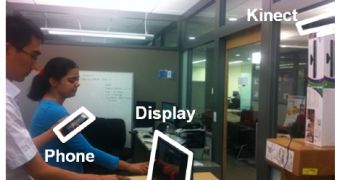Mobile devices are meant to be personal, and the latest advancements in security and privacy protection show that the industry is moving in this direction at full speed.
There are already various security measures that users can benefit from to ensure that sensitive data on their devices is kept away from strangers, yet there is room for more.
PIN codes, unlock patterns, passwords, fingerprint readers and face unlock features already enable people to secure their mobiles, yet Microsoft Research proposes a new approach to users’ interaction with devices.
Called ShakeID, the system is based on reading user’s specific manner of interacting with the device to distinguish between up to two users (because Kinect SDK’s active skeletal tracking is limited to only two people at the moment).
Based on the idea that each person is holding a smartphone that can sense his/her movement, the system can be used for determining who is holding the phone and interacting with it.
“We present ShakeID, a technique for associating a specific user’s touch contacts on an interactive display to a mobile device held by the user. It exploits the combination of the phone’s on-board sensors and touch screen sensing to perform this association,” Microsoft Research notes.
The system takes advantage of Kinect tracking data, and can even determine which hand is used to touch the phone, or can perform a log-out when the user distances from the Kinect sensor and the screen.
“By comparing the motion of each phone in the scene with the motion of each user, the system can associate each phone to a specific user’s hand,” Microsoft Research explains.
“Next, by performing a coordinate transform from the 2D space of the display to the 3D camera space, the touches on the display are associated to users. Touches are thus associated to users and users are associated with devices they hold.”
ShakeID is capable of associating touches with a specific user when two people interact with a display at the same time. Thus, it can deliver the appropriate content to each of them, based on the location they touched the screen.
ShakeID fuses Kinect with mobile device inertial sensing and multi-touch interactive displays. It is based on a two-step process, one associating personal “private” smartphones to users holding them, and the other associating touches on the shared display to users.
There are some limitations that the system faces at the moment, such as the fact that it cannot determine which user is which when they are stationary, or that it won’t work when they are too close to the sensor for it to correctly read data.

 14 DAY TRIAL //
14 DAY TRIAL //